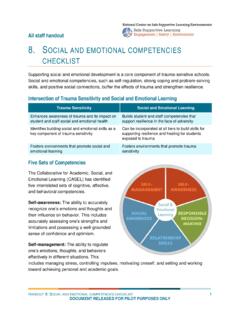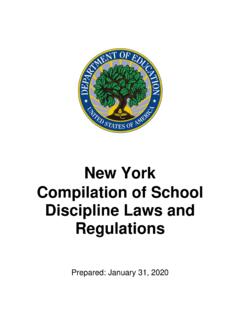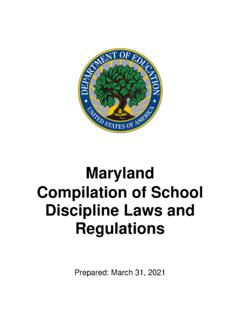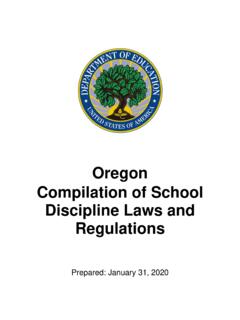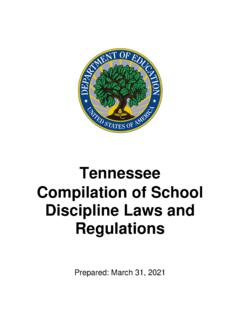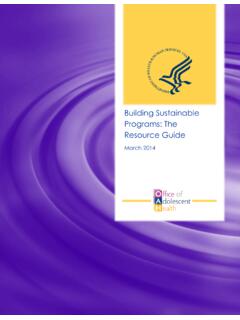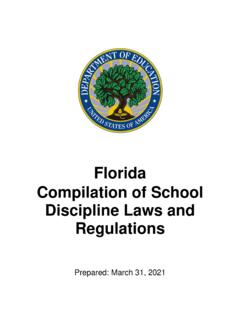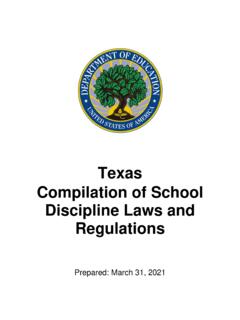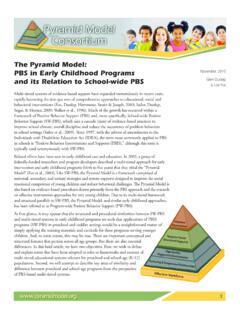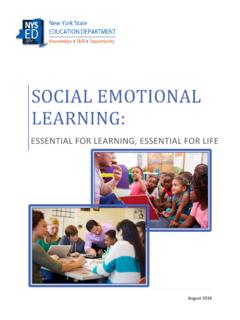Transcription of Effective Planning Strategies for Program Implementation
1 Welcome to Today s Webinar! Effective Planning Strategies for Program ImplementationThis event will start at 4:00 to Today s WebinarAudio Information Dial: 888-843-6165 Conference ID: 7233146 If you have technical difficulties logginginto the web-based portion of the event, please contact Live Meeting Customer support at 1 (866) you have any questions about the Live Meeting technology or the Webinar, please contact SSSTA at 2 Questions, Event Evaluation &Contact InformationQ&AIf you have a question for the presenters, please type it in the Q & A Pane or email the Webinar. EvaluationAn event evaluation will appear as the last slide in the presentation. Please input your answers directlyinto the slide. All answers are completely anonymousand are not visible to other assistance during the Webinar, please contact the Safe and Supportive Schools Technical Assistance Center at Page 3 The Safe and Supportive Schools Technical Assistance Center Funded by the Department of Education s Office of Safe and Healthy Students.
2 * Provides training and support to State education personnel, including the 11 Safe and Supportive Schools grantees; district and school administrators; teachers and school support staff; communities and families; and students. Goal is to improve conditions for learning in schools through measurement and Program Implementation , so that all students have the opportunity to realize academic success in safe and supportive environments.*The content of this presentation was prepared under a contract from the Department of Education, Office of Safe and Healthy Students to the American Institutes for Research (AIR). This presentation does not necessarily represent the policy or views of the Department of Education, nor do they imply endorsement by the Department of 4 Safe and Supportive Schools 5 Polling Question #1 Which of the following best describes your current role?
3 State Education Personnel District or School Administrator Teacher or School support Staff Community or Family Representative Student Researcher OtherPage 6 Polling Question #2 Page 7 Which of the following areas reflect your most pressing Planning needs as you begin implementing programmatic interventions? Data systems Policies Professional development/training Checklists/templates/tools OtherEffective Planning Strategies for Program ImplementationDrs. Don Chapman and Andy Whisman, West Virginia S3 ProgramDr. Kimberly St. Martin, Michigan s Integrated Behavior Learning support Initiative Implementation Webinar Data to Identify Programmatic Interventions (December 2011) Planning Strategies for Program New programs Program Implementation Impact of Program ImplementationPage 9 Page 10 AgendaIntroduction(Sandy Keenan)Getting the support Your School Needs (Dr.)
4 Kim St. Martin)2 Making it Happen in Your School (Dr. Kim St. Martin)West Virginia S3 Program s Implementation Planning Efforts( Chapman and Andy Whisman)134 Model for Identifying and Implementing Programmatic Interventions1. Review data/evaluate2. Assess current programmatic interventions3. Identify change(s) or needed programmatic intervention(s)4. Plan Change(s)5. Implement Change(s)IntroductionImportance of Establishing SupportsPractical Planning StrategiesWV S3 Planning EffortsPage 11 Overview of Take Aways from Previous Webinars Establish school climate team (ideally pre-existing group) that will work together throughout school climate improvement process. Examine a range of data thoroughly to identify target areas, including disaggregated school climate survey data.
5 Identify appropriate programmatic interventions that have demonstrated positive results and align with:-the strengths and needs of your school-the types of improvements desired-your capacity to implement a sustainable Program with fidelity over time-your school setting-other improvement efforts in your school and district Refer to resources that can help teams. Undergo improvement process systematically (SSSTA s Identifying and Implementing Programmatic Interventions, NIRN s Installation Stage Assessment). Locate potential programmatic interventions (SSSTA s List of Evidence Based programs Resources).IntroductionImportance of Establishing SupportsPractical Planning StrategiesWV S3 Planning EffortsBasic Planning Activities to Consider Ensure you have information on all aspects of the chosen programmatic intervention(s).
6 Develop a logic model that aligns with your vision, goals, other plans, and selected programmatic interventions and that will guide Planning and activities for the year. Plan how you will implement each aspect of the programmatic intervention(s).-Determine who will be doing when tasks will be a needed professional access to technology and times to monitor progress throughout the year. Page 13 IntroductionGetting the support Your School NeedsMaking It Happen In Your SchoolWV S3 Planning EffortsPage 14 Logic of MiBLSi A statewide structure to create capacity for an integrated Behavior and Reading Multi Tiered System of Supports (MTSS) system that can be implemented with fidelity, is sustainable over time and utilizes data-based decision making at all levels of Implementation support .
7 -Partnership between Intermediate School Districts (ISDs)/Regional Service Agencies (RESAs) and Local School Districts focuses on shared ownership and accountability around Implementation of an integrated MTSS model. MiBLSiis funded through Michigan Department of Education s Office of Special Education via a State Personnel Development Grant from the Department of Education s Office of Special Education 15 IntroductionGetting the support Your School NeedsMaking It Happen In Your SchoolWV S3 Planning EffortsLogic of MiBLSi(continued) Goal: -Schools/Districts implement MTSS practices with are supported through an infrastructure that promotes continuous improvement and sustainability. Two categories of to Effective practices based on need, fit, resource availability, evidence, readiness for replication, and capacity to support for the Implementation of the practicesPage 16 IntroductionGetting the support Your School NeedsMaking It Happen In Your SchoolWV S3 Planning EffortsConsidering the Science of Implementation A Program or practicebeing considered for adoption requires one set of activities being referred to are things within the Program (or components/steps within the practice) necessary for practitioners to gain familiarity around prior to Implementation .
8 Implementation is a very different set of activities ( developing systems to support implementers, allocation of resources).Citation 1 Page 17 IntroductionGetting the support Your School NeedsMaking It Happen In Your SchoolWV S3 Planning EffortsConsidering the Science of Implementation (continued) Leadership within all layers of the system must support both of these concepts and issues simultaneously. Implementation occurs in stages:-The stages are recursive ( staff turnover may require a need for re-training in the practice/ Program ; school building consolidations may impact scheduling and resources available to support the Implementation of the practice/ Program ).- support to schools/districts must be differentiated by stage of Implementation .
9 - support is needed at all levels of the system ( student level, grade level, building level, district level).Citation 1 Page 18 IntroductionGetting the support Your School NeedsMaking It Happen In Your SchoolWV S3 Planning EffortsSupporting Schools/Districts Through the Stages of Implementation Page 19 Citation 1 District CabinetDistrict Implementation Team Vision Policy Providing for Implementation supports (coaching, training, evaluation) Barrier busting Create materials Collect and summarize data Identify barriers to implementationCoordinationLiaisonDistric t RtICoordinatorImplementation Supports DirectionTrainingCoachingContent ExpertiseMaterialsEvaluationSchoolsDistr ict Infrastructures to support Implementation Page 20 IntroductionGetting the support Your School NeedsMaking It Happen In Your SchoolWV S3 Planning EffortsBuilding by Building Implementation Challenges If district infrastructures to support Implementation are not formally in place, things like principal turnover, staff turnover and building consolidation may quickly dismantle Implementation efforts.
10 -There may be inconsistent Implementation efforts across buildings and grade levels within the around the data, systems and practices might be viewed as a one time event. Once training is done, the belief tends to be we are doing it .-Needs and barriers that need to be addressed with cabinet level leaders (executive leadership) might not be communicated in a formal and timely way, potentially causing building leadership teams to feel stuck .Page 21 IntroductionGetting the support Your School NeedsMaking It Happen In Your SchoolWV S3 Planning EffortsPolling Question #3 Think about Implementation of various programs or school reform initiatives. Which Implementation challenge have you seen occur MOST frequently?

